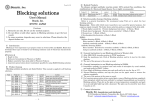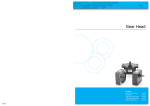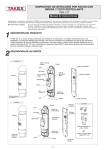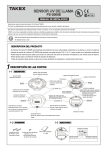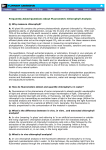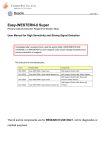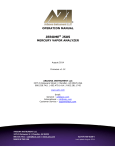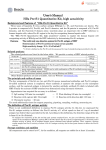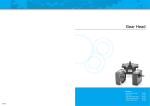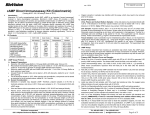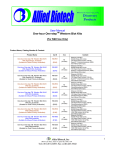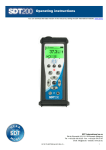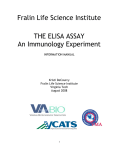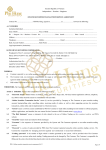Download Manual.
Transcript
Ver.1.01 Easy ELISA Constructor (ab) Antibody-detecting ELISA construction User’s Manual (2) Product information This manual is applied to the product listed below table. Product # Product name BCL-EEC-01 Easy ELISA Constructor (ab) This kit is composed of following reagents. MAD Reagent (HRP labeled) 1 tube Antigen coating buffer 1 bottle 20X conc. washing buffer 1 bottle MAD reaction buffer 1 bottle Mouse IgG enhancer 1 tube Control antibody (rabbit) 1 tube The composition may be changed without notification. (3) Storage Store MAD reagent and control antigen at -20℃. Beacle, Inc. KYOTO JAPAN ---- content ---(1) introduction ・・・・・・・・・・・・・・・・・・・・・・・・・・・・・・・・・・・・・・・・ 2 (2) Product information ・・・・・・・・・・・・・・・・・・・・・・・・・・・・・・・ 2 (3) Product information ・・・・・・・・・・・・・・・・・・・・・・・・・・・・・・・ 2 (4) Storage ・・・・・・・・・・・・・・・・・・・・・・・・・・・・・・・・・・・・・・・・・・・・・ 2 (5) Principle ・・・・・・・・・・・・・・・・・・・・・・・・・・・・・・・・・・・・・・・・・・・ 3 (6) How to use ・・・・・・・・・・・・・・・・・・・・・・・・・・・・・・・・・・・・・・・・・ 3 (7) Trouble Shooting ・・・・・・・・・・・・・・・・・・・・・・・・・・・・・・・・・・ 4 (8) Contact information ・・・・・・・・・・・・・・・・・・・・・・・・・・・・・・・ 4 Cautions 1. Research use only. Do not use for medical purpose. 2. After receiving the kit, store MAD reagent and positive antigen at -20℃ as soon as possible. − 1 − (1) Introduction Easy ELISA Constructor (ab) is a kit to construct antibody detecting ELISA, and evaluate antibodies. The kit is also used for elevation sensitivity by combination use with 2nd antibodies. For ELISA construction, only a half a day is required from examining conditions to establish the assay system using the kit. The constructed ELISA required only 90 min at minimum for one run. Chromogenic reagent (2 solution type) 3X conc. blocking buffer Stop solution 96well microplate (split type) Control antigen Control antibody (mouse) 2 1 1 2 1 1 bottle bottle bottle plates tube tube Store other reagents at 4℃. (4) Principle The evaluation of antibody is conducted as follows; antibody is attached to immobilized antigen, and attached antibody is detected by MAD reagent. MAD reagent is highly sensitive antibody-detecting probe developed in our laboratory. The kit achieves high sensitivity and rapid detection by using MAD reagent. The probe binds most IgGs at high affinity, but weak to some IgGs such as mouse IgG1 and Goat IgG. For mouse IgG, we provide Mouse IgG Enhancer which enables us to detect IgG1 at high sensitivity. The determined value has linearity and can be used for quantitative determination. (5) Application ・Evaluation of antigen-specific IgG in serum from immunized animals. ・Evaluation of IgG whose antigen specificity is not identified. ・Screening during monoclonal antibody preparation. ・Others (6) Reagents and apparatus needed to use the kit ・Antigen (the antigen that the sample antibody binds) ・micropipette ・DW ・Microplate reader(abs=450 nm) ・Microtubes ・8-channel multi-pipette (7) Operation instruction <Outline> ELISA is usually constructed by following two steps using the kit. Step 1 : examination of assay condition (minimum required time: 90 min) In the step, the concentration of immobilized antigen and the rough dilution factor of the sample antibody will be determined. By using control antigen and antibody, confirmation of the assay operation is also possible. 【note】:If these parameters are already known, skip the step. Step 2 : confirmation of dose-response curve (minimum required time: 90 min) Under the condition determined in Step1, get that data at various sample concentrations and draw dose-response curve. <Preparation> ・Dilute 20x conc. Washing Buffer to 20 times with DW. Store at 4℃. ・Dilute 3x conc. Blocking Solution to 3 times with DW. Store at 4℃. ・Add 100µL of DW to Positive Control Antigen tube and mix well. Store at 4℃ (use within 1 month) ・Add 1mL of diluted washing buffer to Positive Control Antibody tube and mix well. Store at 4℃ (use within 1 month) − 2 − <Step 1> Determination of ELISA conditions 1.Preparation of plate Prepare strips of ELISA plate. The number of strips required should be determined according to the next two instructions (2 and 3). Do not forget to prepare blank wells. 2.Coating plates with antigen Prepare original antigen solution at 100µg/mL with DW. Using the original solution, make a dilution series of antigen with coating buffer. The required volume of coating antigen should be determined according to the description below. In general, the range of antigen concentration is between 10 to 0.01µg/mL, but we recommend using much wider range if possible. Add 100µL of the dilutions into two wells each (duplicate determination). For blank wells, add 100µL of washing buffer. Incubate the plate for 20 (or 60) min at 37℃. 3.Preparation of dilution series of samples containing antibodies. This procedure should be done during the above incubation time to save time. Make dilution series of samples with washing buffer. Use washing buffer alone for blanks. In general, the range is between 100 to 10000 times dilution for antiserum, and 10ng∼ 1µg/mLµg/mL for antibodies, but we recommend to use the range as wide as possible. 4.Washing and blocking After incubation, discard the solution from wells, and wash wells with 300µL of washing buffer 3 times. At the end of washing, tap the plate on the paper towel to remove solutions as much as possible. Then, add 200µL of blocking solutions to each well, and incubate the plate for 20 (or 60) min at 37℃. After the incubation, discard the blocking solution from wells, and tap the plate on the paper towel to remove solutions as much as possible. 5.Reaction with samples Add 100µL of diluted samples to blocked wells. Then incubate for 20 (or 60) min at 37℃. 7.Preparation of MAD reagent This procedure should be started a few min. before the end of sample incubation. Take appropriate volume of MAD Reaction Buffer (ten wells require 1mL of volume. consider the dead volume of reservoir when using 8-channel multi-pipette). Add 1/2000 volume (0.5µL/1 mL) of original conc. MAD reagent to MAD reaction buffer, and mix well. When detecting mouse antibody, further add 1/2000 volume of Mouse IgG Enhancer, and mix well. 【note】 Mouse IgG Enhancer should be used only when the sample is form mouse. 8.Reaction with MAD reagent After the sample incubation, discard the solution from wells, and wash wells with 300µL of washing buffer 3 times. At the end of washing, tap the plate on the paper towel to remove solutions as much as possible. Then add 100µL of prepared MAD reagent to wells and incubate for 15(30)min at 37℃. 9.Chromogenic reaction After the MAD incubation, discard the solution from wells, and wash wells with 300µL of washing buffer 5 times. At the end of washing, tap the plate on the paper towel to remove solutions as much as possible. Mix the equal volume of Chromogenic Reagent A and B, and add 100 µLof the mixture to each well using 8-channel multi-pipette, and incubate the plate at room temperature for 15(30) min in dark container. After checking the blue color of wells, add 75µL of Stop Solution using 8-channel multi-pipette. Read the absorbance at 450 nm by plate reader. 10.Interpretation of results Adequate conc. of coating antigen is the concentration where the maximal response can be seen with the lower sample antibody concentration. Considering the reproducibility, the maximal absorbance should be more than 1.5. If the result does not meet the criteria, try again with different conditions. Adequate conc. range of sample antibody is, by using the above selected antigen concentration, that between the lowest concentration of sample where the absorbance is obviously higher than blank and that where the absorbance is slightly larger than 2.5. 11.Usage of Positive Control Positive Control can be used for the confirmation of right procedures. To do so, prepare 4 additional wells in the process described above protocol. The wells are coated by Positive Control Antigen (dilute 5µLof solution prepared in “Preparation” with 500µLof coating buffer). Add 100µL of Washing Buffer or Positive Control Antibody (the solution prepared in “Preparation” section) to 2 wells each. All procedures should be done at the same time with samples including washing and chromogenic reaction. If the ELISA procedure goes well, the absorbance will be below 0.3 for blank, and over 2.0 for positive control. 【note】 Two kinds of control antibodies are provided. When using Mouse IgG Enhancer, chose mouse antibody for control. Rabbit antibody is the control for most other antibodies. <Step 2> Dose-response curve and comparison with positive control The experimental procedure is essentially the same as that in Step1. The instruction is described only for the point important for this step. − 3 − 12.Coating of plates with antigen Prepare required strips of ELISA plate, and coat with antigens at the concentration determined in Step1. For positive control, coat with Positive Control Antigen solution (dilute the antigen solution to 100 times with coating buffer). It is recommended for all samples and the positive control to prepare wells enough for duplicate determination with 8 (including blank) antibody concentrations. 13.Preparation of sample and control antibody solution For positive control antibody, the antibody solution prepared in ”Preparation” is the highest concentration, the solution is diluted to 3, 10, 100, 300, and 1000 times with Washing Buffer to make 7 dilution series. Dilute the sample antibody solution in similar manner to make 7 dilution series considering the results obtained in Step1. 【note】 Make sure that you are using right control antibody. 14.From sample addition to the reading Add 100μL of samples to wells that has been coated with antigens and treated with blocking solutions, and make it react. The following procedure is the same as Step1. 15.Interpretation of the results in comparison with positive control ・100 x stronger than positive control: very high affinity, may be used by 10000 x dilution ・10 x stronger than positive control: high affinity, may be used by 1000 to 10000 x dilution ・Equal to positive control:moderate affinity, may be used by 100 to 1000 x dilution ・Below 1/10 of positive control:low affinity, possibly used by 100 x dilution 【note】 The above interpretation is good when the coating antigen concentration is 1μg/mL. If the concentration is lower the antibody has higher affinity and vice versa. <Enhancing ELISA sensitivity by combination with 2nd antibody> In the IgG-detecting ELISA system using HRP-labeled antibody for antibody detection, the combination use of this kit can enhance the sensitivity more than 10 times. 1. Dilute the original MAD solution to 1/2000 by MAD Reaction Buffer. 2. There are two ways to use the diluted MAD reagent. Method 1. After the step that the 2nd antibody is added to detect antigen-bound antibody, and antibody solution discarded, add the diluted MAD reagent at the same volume of 2nd antibody. Method 2. To the diluted MAD reagent add original 2nd antibody solutions at the amount to make usual concentration, mix well, and leave it for a few min. Add the mixture to wells as usually does with 2nd antibody. 3. Incubate for 30 to 60 min at desired temperature. 4. The following steps are the same as usual. 【note】 The degree of enhancement may vary depending on the IgG (origin of animal, subtype) . 【note】 The attached blocking solution is designed for long term storage of pre-coated plates. After coating and blocking, dry up the plates at room temperature, and store in dry and light-tight conditions at 4℃. The pre-coated plates can be stored for more than 6 months. (8) Trouble shooting trouble Cause and measures Weak 1. Short incubation time. Use longer incubation time as indicated parenthesis in the signal instruction. 2. Not enough antigen coating. Confirm the signal strength of positive control. If the signal is strong, it is likely that the target antigen is not well immobilized. Consider to use our product, “Peptides immobilizing kit” 3. Low antibody binding to coated antigen. The amount of bound antibody is directly related with signal strength, and is dependent on the antibody’s affinity to antigens and amount of antibody. Check the concentration of samples. High 4. Not enough blocking. The blank value of the kit is 0.2 to 0.25 at maximum. If the blank blank value is much higher, prolong the blocking time. signal 5.Low purity of antigen. Low purity antigen causes various reaction with antibodies or MAD reagent and increases blank value. Increase the purity. (9) Contact information Beacle, Inc. (manufacturer and distributor) 10-25 Kamikazan-Sakajiri, Yamashina-Ku, Kyoto, 607-8465 Japan E-mail: [email protected] Website: www.beacle.com − 4 −


